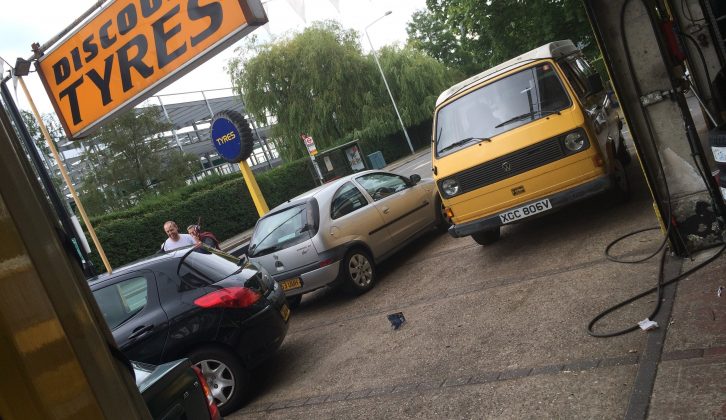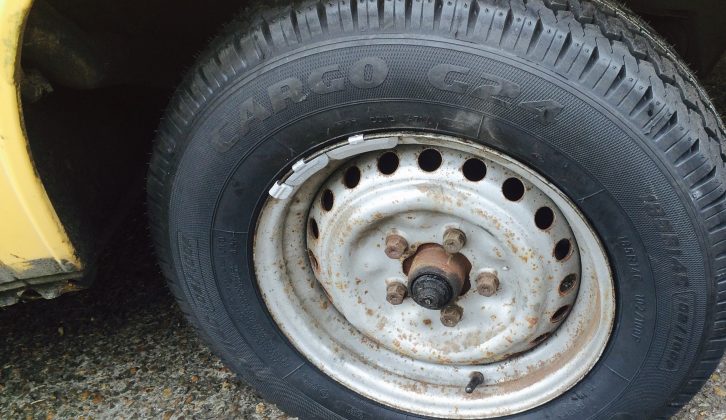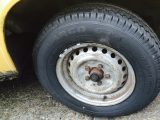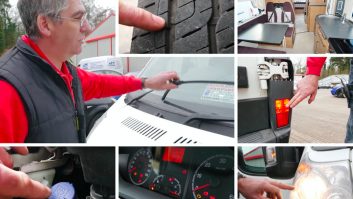As you’ll have discovered in my recent blog, I’ve bought a new project: Wilma, a 1980 Volkswagen ‘T25’ Transporter. And when I take delivery of a used car, caravan or motorhome, one of the first things I always attend to is the tyres. It is a bit yawn-inducing when someone repeats the old adages about the tyres being the only point of contact with the road, and the most important safety feature you have, but it is nonetheless true.
Unsexy, and potentially expensive as it would likely be, in my heart, I knew that the tyres on our VW campervan were a bit sad.
The first thing to do was assess just how sad. When picking the ‘van up, I noticed the front left was obviously past its best, having a very shiny outer edge. It was a Fate tyre which my regular tyre garage explained was not a premium piece of kit, but far from the worst on the market. It had a very ominous bulge in it, however. It was scrap and I was glad it was being removed from the campervan.
On the back left-hand corner was a Continental Contrans, which is at least a good make. Apparently, it is some sort of winter tyre and looking at the state of it, this had seen quite a few of them. A quick look at the date code showed it was from 1995. Even my rudimentary maths let me understand that a 20-year-old tyre keeping Wilma off the road was not a good idea.
The right rear was a surprisingly modern Hankook RA08 van tyre with plenty of tread and no obvious signs of abuse. The front right was a Barum of considerable vintage. The spare was buried underneath, but I presumed it was unlikely to be better than anything fitted to the ‘van.
This brief survey confirmed what I already knew: Wilma needed four new tyres. But the final nail in their collective coffin was the on-road behaviour. The steering was heavy, regardless of tyre pressure. Wilma fidgeted about and there was a definite tremor through the steering once you got beyond 40mph or so.
The 185/14C tyres are small by modern standards but there is plenty of choice and, in truth, the difference in price between a budget tyre and something a little more premium wasn’t too bad. A deal was struck for four Goodyear Cargo G24s. The total price, including fitting, balancing, disposal of the old tyres and getting Wilma’s tracking done gave me change from £300. Not much, but a little. The price also included swapping the ancient spare tyre for the serviceable Hankook which was on the ‘van.
The difference on the road was striking. Straightaway, the steering felt lighter. I had inflated Wilma’s tyres the day after collecting her to try and lighten the steering and improve the on-road behaviour. The handbook suggested pressures for a Volkswagen T25 should be between 40 and 52psi. They were at 32psi. Pumping them up to 40psi improved things, but the combination of new tyres and corrected tracking helped things beyond measure.
Now, when driving down the road, Wilma no longer heads straight to the kerb, constantly wandering about. The steering wheel points the correct way, too. Once up to speed, she is quieter on faster roads too and, although I’ve had no chance to find out, I’m sure she will stop and grip better too. Perhaps the best upside of the new tyres, however, is the extra confidence it provides.
Running a vehicle of Wilma’s age is always likely to throw up a few problems. It’s old technology and there has been plenty of opportunity in the 35 years since she left the Wolfsburg factory for wear and tear to take hold. Things will break and need repair.
One thing that there is no excuse for, however, is an age-related tyre failure. If your tyres are getting old, are damaged or discoloured, have them inspected and replace them before they cause a problem. Because they will.
And unlike an exhaust or a clutch problem, a tyre failure could do more than ruin your holiday. It could kill someone.
It’s not the sexiest £300 you’ll ever spend, but I’d suggest there will be few more important.
Even my rudimentary maths let me understand that a 20-year-old tyre keeping Wilma off the road was not a good idea














